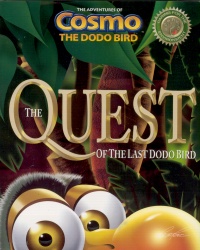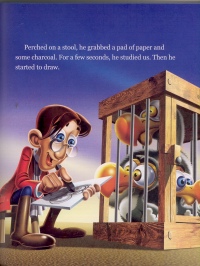| ________________
CM . . . . Volume XVIII Number 6 . . . . October 7, 2011
excerpt:
The Quest of the Last Dodo Bird is the first book in a four-part series that relates the adventures of the last remaining dodo bird on Earth. The initial pages of the book introduce the two key characters that anchor the series: Cosmo, the dodo bird, and 3R-V, a sentient spaceship/robot, sent from the future to rescue species that have become extinct. The reader learns that 3R-V meets Cosmo on Earth and, together, they roam the universe in search of other members of the dodo species. The reader is assured that "many adventures" will ensue. In this first book, Cosmo must battle blood-thirsty pirates and giant rats while coping with the demise of his friends and family members.
The best feature of this book is its computer-generated illustrations. They are detailed, colourful, and interesting. When present on a particular page, the illustrations enhance the storyline. The characters show a wide range of expressions. Geographical and anatomical features appear to be accurate. However, the illustrations seem ripe for the development of a television series or movie, adding a commercial feel to the book. Nevertheless, The Quest of the Last Dodo Bird should be appealing to children who enjoy adventure tales. Recommended. Roxy Garstad is a librarian at Grant MacEwan University in Edmonton, AB. The reviewer would like to thank Tara Stieglitz of the Edmonton Public Library for her comments.
To comment
on this title or this review, send mail to cm@umanitoba.ca.
Copyright © the Manitoba Library Association. Reproduction for personal
use is permitted only if this copyright notice is maintained. Any
other reproduction is prohibited without permission.
NEXT REVIEW |
TABLE OF CONTENTS FOR THIS ISSUE
- October 7, 2011.
AUTHORS |
TITLES |
MEDIA REVIEWS |
PROFILES |
BACK ISSUES |
SEARCH |
CMARCHIVE |
HOME |

 The text is divided into 14 chapters, with a lengthy prologue that would have made an ideal first chapter. The book oscillates between Cosmo's first-person narrative (from 300 years ago) and the third-person narratives of 3R-V and his creator, Professor Nino (from the future). These changes in perspective are clearly marked at the beginning of the relevant chapters. Rarely more than three-quarters of a page – usually half of the page – is devoted to text, which seems visually awkward and wasteful of paper, especially since the book purports to value environmentalism. The text, itself, seems more suited to a younger age group than the book advertises, with simple language and many short, jerky sentences. This choppiness slows down the reading pace and, occasionally, makes the text a chore to read. Non-inclusive language (e.g. "the world known to man") is not acceptable. The text also does little for character development – some readers may be left wondering how Cosmo manages the eradication of his species with such composure.
The text is divided into 14 chapters, with a lengthy prologue that would have made an ideal first chapter. The book oscillates between Cosmo's first-person narrative (from 300 years ago) and the third-person narratives of 3R-V and his creator, Professor Nino (from the future). These changes in perspective are clearly marked at the beginning of the relevant chapters. Rarely more than three-quarters of a page – usually half of the page – is devoted to text, which seems visually awkward and wasteful of paper, especially since the book purports to value environmentalism. The text, itself, seems more suited to a younger age group than the book advertises, with simple language and many short, jerky sentences. This choppiness slows down the reading pace and, occasionally, makes the text a chore to read. Non-inclusive language (e.g. "the world known to man") is not acceptable. The text also does little for character development – some readers may be left wondering how Cosmo manages the eradication of his species with such composure.